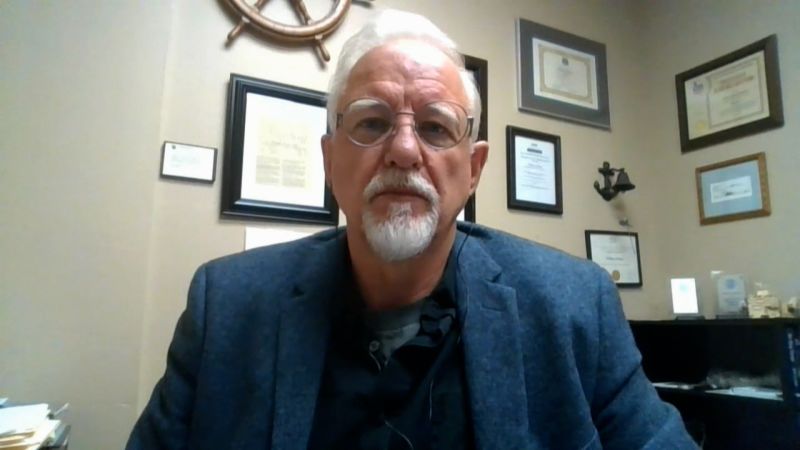One week after the Titan submersible started what became a catastrophic underwater voyage to the Titanic wreckage – killing all five people aboard – US officials laid out their next steps in investigating the disaster.
The US Coast Guard announced Sunday it convened a Marine Board of Investigation to probe the implosion – the “highest level of investigation the Coast Guard conducts,” US Coast Guard chief investigator Capt. Jason Neubauer said.
The panel will be tasked with determining what caused the tragedy and offer possible recommendations “to the proper authorities to pursue civil or criminal sanctions as necessary,” Neubauer said at a Sunday news conference.
The Coast Guard probe – one of several announced since the Titan imploded – is just beginning and will concentrate on collecting debris from the wreckage and interviews. After that, the board will hold a public hearing to gather additional testimony from witnesses, Neubauer said. It will then issue a report with evidence, conclusions and recommendations, he added.
As officials try to piece together exactly what happened, investigators will also be reviewing voice recordings from the mother ship that carried the vessel and its five occupants, Canadian officials said.
Canadian investigators boarded that ship, the Polar Prince, on Saturday “to collect information from the vessel’s voyage data recorder and other vessel systems that contain useful information,” Kathy Fox, chair of the Transportation Safety Board of Canada, said Saturday. A voyage data recorder stores audio from the ship’s bridge.
The crew and family members were also being interviewed aboard the Polar Prince, which returned to St. John’s, the capital of Newfoundland and Labrador, with its flags at half-mast Saturday.
The agency’s mission isn’t to assign blame, but rather “find out what happened and why and to find out what needs to change to reduce the chance or the risk of such occurrences in the future,” Fox said.
The Royal Canadian Mounted Police is also investigating the incident and said it is looking into whether “criminal, federal, or provincial laws may possibly have been broken.”
Communications between the submersible and its mother ship will also likely be scrutinized by officials probing the disaster. The ship could communicate with the submersible by text messages, and it’s required to communicate every 15 minutes, according to the archived website of OceanGate Expeditions.
The latest announcements come just about three days since the US Coast Guard announced the vessel had suffered a “catastrophic implosion” that killed all those aboard. Military experts found debris in the ocean – about 1,600 feet from the bow of the Titanic – consistent with the loss of the small vessel’s pressure chamber, US Coast Guard Rear Adm. John Mauger said.
Those killed were Stockton Rush, CEO of the vessel’s operator OceanGate Expeditions; British businessman Hamish Harding; French diver Paul-Henri Nargeolet; and Pakistani-born businessman Shahzada Dawood and his son, Suleman, who were British citizens.
Titan recovery mission continues on the sea floor
The Odysseus 6K, a remotely operated vehicle, is on the seafloor in its fourth dive since arriving at the Titan rescue site, the statement said.
The vehicles that have been gathering information from the sea floor have worked to map out the vessel’s debris field, which is more than 2 miles deep in the North Atlantic, Mauger, the US Coast Guard Rear Admiral, has said.
Five different major pieces of debris from the submersible were found Thursday morning, officials said. Each end of the pressure hull was found in a different place, according to Paul Hankins, US Navy director of Salvage Operations and Ocean Engineering.
ROV missions are expected to continue for about another week, according to Jeff Mahoney, spokesperson for Pelagic Research Services, a company that specializes in ocean expedition.
Questions about Titan’s design
The multinational investigation comes amid mounting questions about the Titan’s design.
The company strayed from industry norms by declining a voluntary, rigorous safety review of the vessel, according to an industry leader.
And when submersible expert Karl Stanley was aboard the Titan for an underseas excursion off the coast of the Bahamas in April 2019, he felt there was something wrong with the vessel when loud noises were heard and sent an email to Rush, the CEO of OceanGate Expeditions, sounding the alarm on suspected defects.
Read more
Remembering those on boardWhat is a catastrophic implosion?Employees had previously raised safety concernsCould this lead to more safety regulations?See inside the submersible
“From the intensity of the sounds, the fact that they never totally stopped at depth, and the fact that there were sounds at about 300 feet that indicated a relaxing of stored energy/would indicate that there is an area of the hull that is breaking down/ getting spongy,” Stanley continued.

